 |
1/13/99
Along with the bones and shoe parts found on Gardner Island (Nikumaroro) in 1940 was a box which was judged to have once contained a nautical sextant. Written on the box were numbers which could be the key to establishing the origin of the box and possibly the identity of the person whose bones were found with it. We do not know if the box still exists (it was last known to be in Fiji in 1941), nor do we know for sure just what it looked like. Here are the descriptions we do have:
| Date: | Sept. 23, 1940 – Telegram |
| From: | Gerald Gallagher, Officer in Charge, Phoenix Island Settlement Scheme, Gardner Island |
| To: | Jack Barley, Resident Commissioner, Gilbert & Ellice Islands Colony, Ocean Island |
| Text: | Thorough search has now produced more bones (including lower jaw ) part of a shoe a bottle and a sextant box. It would appear that … Sextant box has two numbers on it 3500 (stencilled) and 1542 – sextant being old fashioned and probably painted over with black enamel. |
| Date: | April 28, 1941 – Telegram |
| From: | Gerald Gallagher, Officer in Charge, Phoenix Island Settlement Scheme, Gardner Island |
| To: | Henry Harrison Vaskess, Secretary, Western Pacific High Commission, Suva, Fiji |
| Text: | [N]o sextant was found. Only part discovered was thrown away by finder but was probably part of an inverting eyepiece. |
| Date: | August 8, 1941 – Typed note to Western Pacific High Commission file 4439-40 |
| From: | Sir Harry Luke, High Commissioner of the Western Pacific, Suva, Fiji |
| To: | Henry Harrison Vaskess, Secretary, Western Pacific High Commission, Suva, Fiji |
| Text: | Mr. Gatty [note: we suspect that “Mr. Gatty” is the famous Tasmanian-born aerial navigator Harold Gatty] thinks that the box is an English one of some age and judges that it was used latterly merely as a receptacle. He does not consider that it could in any circumstance have been a sextant box used in modern trans-Pacific aviation. |
| Date: | August 11, 1941 – Note to Western Pacific High Commission file 4439-40 |
| From: | Patrick Macdonald, Ass’t Secretary, Western Pacific High Commission, Suva, Fiji |
| To: | Henry Harrison Vaskess, Secretary, Western Pacific High Commission, Suva, Fiji |
| Text: | Quoting Commander G. B. Nasmyth, Fijian Royal Meteorological Society: [A]ll I have been able to find out is that the make of the box – that is – the dovetailing of the corners – makes it appear to be of French origin. |
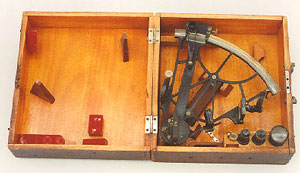 |
A nautical sextant in the collection of the National Museum of Naval Aviation in Pensacola, Florida was borrowed from Earhart’s navigator, Frederick J. Noonan, by a Pan American pilot who was taking navigational instruction from Noonan. Fred is known to have habitually carried a nautical sextant with him in addition to an aeronautical bubble octant. The instrument in Pensacola was manufactered by W. Ludolph, Bremerhaven, Germany in 1919 and carries the serial number 1090. It is painted black. |
|
The only markings on the box, which features dovetailed corners, are the number 116 handwritten on the front … |
|
|
|
The fastening hooks on the German and British boxes appear to be of identical design and are different from those on the Pensacola box. The hooks on the Pensacola box rotate inwards as do the hooks on the other German sextant box. The the hooks on the British box swing outward. The British box also has no handle on the front. We can’t see enough of the German box to tell whether or not it has a handle. No markings are visible on either the German or the British boxes, but again, we can’t see the entire boxes. We’d like to hear from anyone who can add anything to this rather obscure avenue of research. We would particularly like to know if the reportedly stencilled “3500” and apparently not-stencilled “1542” on the Nikumaroro box have any documentable significance. |
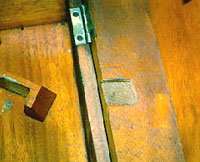 The
box in which it was kept appears to be mahogany. A small notch has
been crudely cut into the inside rear of the cover. The notch is
not required to accommodate the Ludolph sextant.
The
box in which it was kept appears to be mahogany. A small notch has
been crudely cut into the inside rear of the cover. The notch is
not required to accommodate the Ludolph sextant. 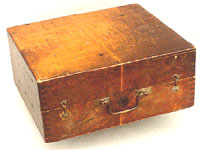
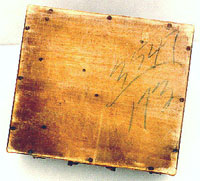 …
and the numbers 3547 and 173 handwritten on the bottom. The style
of the handwritten numbers is not unlike Noonan’s handwriting but
neither is it distinctive enough to be certain that numbers were
written by Noonan. Of approximately 500 sextant boxes examined in
collections in the U.S. and in Britain, this is the only one which
features numbers written on the exterior of the box.
…
and the numbers 3547 and 173 handwritten on the bottom. The style
of the handwritten numbers is not unlike Noonan’s handwriting but
neither is it distinctive enough to be certain that numbers were
written by Noonan. Of approximately 500 sextant boxes examined in
collections in the U.S. and in Britain, this is the only one which
features numbers written on the exterior of the box. 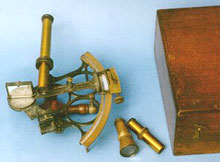 A
box similar in appearance to the Pensacola box is this box for another
German sextant. The instrument is described as German-made for the
American market, and the sextant is marked only “Eugenes Fabricat.”
A paper trade label inside the box lid reads “Negus Nautical Instruments,
69 Pearl Street, New York.” The black finish on the brass is poor.
The rectangular fitted box has dovetailed joints.
A
box similar in appearance to the Pensacola box is this box for another
German sextant. The instrument is described as German-made for the
American market, and the sextant is marked only “Eugenes Fabricat.”
A paper trade label inside the box lid reads “Negus Nautical Instruments,
69 Pearl Street, New York.” The black finish on the brass is poor.
The rectangular fitted box has dovetailed joints. 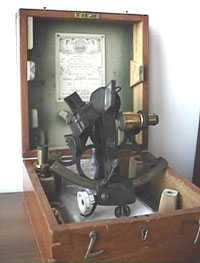 Another
similar box contains this W.W. II era Merchant Marine English Sextant
manufactured by Henry Hughes & Son Ltd. The sextant comes with what
appears to be original owner’s paperwork consisting of invoice dated
3/28/45 made out to M.C. Klein, 3rd Officer of SS George Dewey.
It, too, is painted black.
Another
similar box contains this W.W. II era Merchant Marine English Sextant
manufactured by Henry Hughes & Son Ltd. The sextant comes with what
appears to be original owner’s paperwork consisting of invoice dated
3/28/45 made out to M.C. Klein, 3rd Officer of SS George Dewey.
It, too, is painted black. 